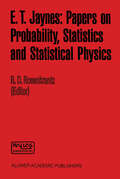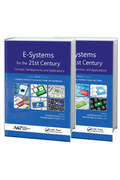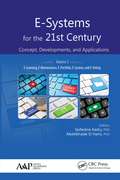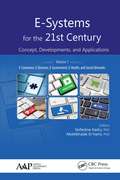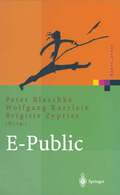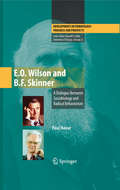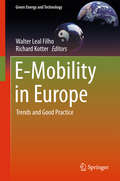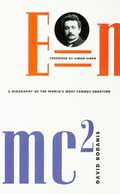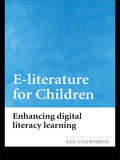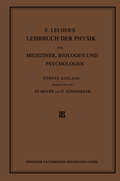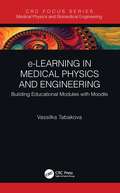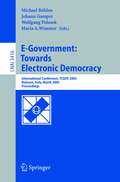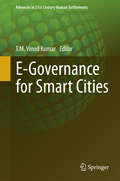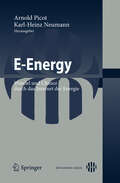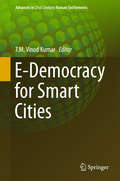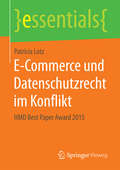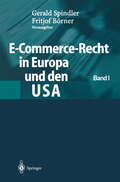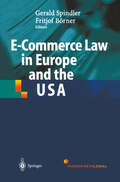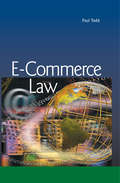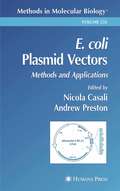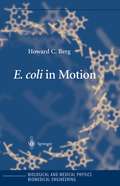- Table View
- List View
E. T. Jaynes: Papers on Probability, Statistics and Statistical Physics (Synthese Library #158)
by R. D. RosenkrantzThe first six chapters of this volume present the author's 'predictive' or information theoretic' approach to statistical mechanics, in which the basic probability distributions over microstates are obtained as distributions of maximum entropy (Le. , as distributions that are most non-committal with regard to missing information among all those satisfying the macroscopically given constraints). There is then no need to make additional assumptions of ergodicity or metric transitivity; the theory proceeds entirely by inference from macroscopic measurements and the underlying dynamical assumptions. Moreover, the method of maximizing the entropy is completely general and applies, in particular, to irreversible processes as well as to reversible ones. The next three chapters provide a broader framework - at once Bayesian and objective - for maximum entropy inference. The basic principles of inference, including the usual axioms of probability, are seen to rest on nothing more than requirements of consistency, above all, the requirement that in two problems where we have the same information we must assign the same probabilities. Thus, statistical mechanics is viewed as a branch of a general theory of inference, and the latter as an extension of the ordinary logic of consistency. Those who are familiar with the literature of statistics and statistical mechanics will recognize in both of these steps a genuine 'scientific revolution' - a complete reversal of earlier conceptions - and one of no small significance.
E-Systems for the 21st Century: Concept, Developments, and Applications - Two Volume Set
by Seifedine Kadry Abdelkhalak El HamiE-based systems and computer networks are becoming standard practice across all sectors, including health, engineering, business, education, security, and citizen interaction with local and national government. They facilitate rapid and easy dissemination of information and data to assist service providers and end-users, offering existing and newly engineered services, products, and communication channels. Recent years have witnessed rising interest in these computerized systems and procedures, which exploit different forms of electronic media to offer effective and sophisticated solutions to a wide range of real-world applications. With contributions from researchers and practitioners from around the world, this two-volume book discusses and reports on new and important developments in the field of e-systems, covering a wide range of current issues in the design, engineering, and adoption of e-systems. E-Systems for the 21st Century: Concept, Developments and Applications focuses on the use of e-systems in many areas of sectors of contemporary life, including commerce and business, learning and education, health care, government and law, voting, and service businesses. The two-volume book offers comprehensive research and case studies addressing e-system use in health, business, education, security, and citizen interaction with local and national government. Several studies address the use of social networks in providing services as well as issues in maintenance and security of e-systems as well. This collection will be valuable to researchers at universities and other institutions working in these fields, practitioners in the research and development departments in industry, and students conducting research in the areas of e-systems. The book can be used as an advanced reference for a course taught at the undergraduate and graduate-level in business and engineering schools as well.
E-Systems for the 21st Century: Concept, Developments, and Applications - Two Volume Set
by Seifedine Kadry Abdelkhalak El HamiE-based systems and computer networks are becoming standard practice across all sectors, including health, engineering, business, education, security, and citizen interaction with local and national government. They facilitate rapid and easy dissemination of information and data to assist service providers and end-users, offering existing and newly engineered services, products, and communication channels. Recent years have witnessed rising interest in these computerized systems and procedures, which exploit different forms of electronic media to offer effective and sophisticated solutions to a wide range of real-world applications. With contributions from researchers and practitioners from around the world, this two-volume book discusses and reports on new and important developments in the field of e-systems, covering a wide range of current issues in the design, engineering, and adoption of e-systems. E-Systems for the 21st Century: Concept, Developments and Applications focuses on the use of e-systems in many areas of sectors of contemporary life, including commerce and business, learning and education, health care, government and law, voting, and service businesses. The two-volume book offers comprehensive research and case studies addressing e-system use in health, business, education, security, and citizen interaction with local and national government. Several studies address the use of social networks in providing services as well as issues in maintenance and security of e-systems as well. This collection will be valuable to researchers at universities and other institutions working in these fields, practitioners in the research and development departments in industry, and students conducting research in the areas of e-systems. The book can be used as an advanced reference for a course taught at the undergraduate and graduate-level in business and engineering schools as well.
E-Systems for the 21st Century: Concept, Developments, and Applications, Volume 2: E-Learning, E-Maintenance, E-Portfolio, E-System, and E-Voting
by Seifedine Kadry Abdelkhalak El HamiE-based systems and computer networks are becoming standard practice across all sectors, including health, engineering, business, education, security, and citizen interaction with local and national government. With contributions from researchers and practitioners from around the world, this two-volume book discusses and reports on new and important developments in the field of e-systems, covering a wide range of current issues in the design, engineering, and adoption of e-systems.
E-Systems for the 21st Century: Concept, Developments, and Applications, Volume 1: E-Commerce, E-Decision, E-Government, E-Health, and Social Networks
by Seifedine Kadry Abdelkhalak El HamiE-based systems and computer networks are becoming standard practice across all sectors, including health, engineering, business, education, security, and citizen interaction with local and national government. With contributions from researchers and practitioners from around the world, this two-volume book discusses and reports on new and important developments in the field of e-systems, covering a wide range of current issues in the design, engineering, and adoption of e-systems.
E-Public: Strategien und Potenziale des E- und Mobile Business im öffentlichen Bereich (Xpert.press)
by P. Blaschke W. Karrlein B. ZypriesE-Business und Mobile Business verändern massiv die Art und Weise, wie viele Geschäftsprozesse in Unternehmen und Organisationen ablaufen. Dabei spielen diese Veränderungen in immer größerem Maße auch in den gesamten öffentlichen Bereich hinein, von der Verwaltung bis zur Regierung. E-Government oder E-Public sind Schlagworte, die nur dürftig die Herausforderungen bezeichnen, die sich dahinter für die Mitarbeiter wie auch für die Bürger und Unternehmen verbergen. Die Einführung neuer E-Business- oder -Mobile-Lösungen erfordert dabei eine Strategie für neue Prozessmodelle, um das Potenzial im öffentlichen Bereich zu nutzen. Die Besonderheit des Buches liegt in der praxisorientierten Darstellung strategischer und konzeptioneller Ansätze, die durch reale Praxisbeispiele unterstützt wird. Es geht gezielt auf die Situation des öffentlichen Sektors ein und zeigt, wie die notwendige Transformation zum E-Public-Sektor bewältigt werden kann.
E.O. Wilson and B.F. Skinner: A Dialogue Between Sociobiology and Radical Behaviorism (Developments in Primatology: Progress and Prospects)
by Paul NaourReviewers have characterized Paul Naour's A Dialogue Between Sociobiology and Radical Behaviorism, which includes brief introductions by E.O. Wilson and B.F. Skinner's elder daughter, Julie Vargus, as an idea book. The work will undoubtedly have a significant academic market and provide students and scholars in biology, ethology, psychology, anthropology, sociology and economics a strong foundation in twentieth century history and systems. Praise for A Dialogue Between Sociobiology and Radical Behaviorism: - E.O. Wilson says of the book: ". . . excellent, an outstanding addition to the history of ideas. It will put Fred Skinner back in the pantheon and, providing context, serve as an excellent introduction to the content and central truths in radical behaviorism. Needless to say, I'm also grateful to have my work following Sociobiology given proper attention." -David Sloan Wilson, author of Darwin’s Cathedral writes: "E.O. Wilson and B.F. Skinner agreed that the human capacity for change is both a product of genetic evolution and an evolutionary process in its own right. Yet, the paradigms of sociobiology and radical behaviorism went in very different directions. Paul Naour's insightful analysis of a taped conversation between Wilson and Skinner goes beyond the historical significance of the conversation and helps to integrate the two paradigms for the future." -Carl Haywood writes: "The present question is whether evolution by natural selection is a useful set of concepts for the development of psychology. Naour’s proposed confluence of radical behaviorism and sociobiology suggests not only that it is, but also that radical behaviorism shares with sociobiology a debt and an allegiance to Darwinism."
E-Mobility in Europe: Trends and Good Practice (Green Energy and Technology)
by Walter Leal Filho Richard KotterFocusing on technical, policy and social/societal practices and innovations for electrified transport for personal, public and freight purposes, this book provides a state-of-the-art overview of developments in e-mobility in Europe and the West Coast of the USA. It serves as a learning base for further implementing and commercially developing this field for the benefit of society, the environment and public health, as well as for economic development and private industry. A fast-growing, interdisciplinary sector, electric mobility links engineering, infrastructure, environment, transport and sustainable development. But despite the relevance of the topic, few publications have ever attempted to document or promote the wide range of electric mobility initiatives and projects taking place today. Addressing this need, this publication consists of case studies, reports on technological developments and examples of successful infrastructure installation in cities, which document current initiatives and serve as an inspiration for others.
E=mc2: A Biography of the World's Most Famous Equation
by David BodanisGenerations have grown up knowing that the equation E=mc2 changed the shape of our world, but never understanding what it actually means, why it was so significant, and how it informs our daily lives today--governing, as it does, everything from the atomic bomb to a television's cathode ray tube to the carbon dating of prehistoric paintings. In this book, David Bodanis writes the "biography" of one of the greatest scientific discoveries in history--that the realms of energy and matter are inescapably linked--and, through his skill as a writer and teacher, he turns a seemingly impenetrable theory into a dramatic human achievement and an uncommonly good story.
E-literature for Children: Enhancing Digital Literacy Learning
by Len UnsworthAs ICT continues to grow as a key resource in the classroom, this book helps students and teachers to get the best out of e-literature, with practical ideas for work schemes for children at all levels. Len Unsworth draws together functional analyses of language and images and applies them to real-life classroom learning environments, developing pupils’ understanding of ‘text’. The main themes include: What kinds of literary narratives can be accessed electronically? How can language, pictures, sound and hypertext be analysed to highlight the story? How can digital technology enhance literary experiences through web-based 'book talk' and interaction with publishers' websites? How do computer games influence the reader/ player role in relation to how we understand stories?
E-literature for Children: Enhancing Digital Literacy Learning
by Len UnsworthAs ICT continues to grow as a key resource in the classroom, this book helps students and teachers to get the best out of e-literature, with practical ideas for work schemes for children at all levels. Len Unsworth draws together functional analyses of language and images and applies them to real-life classroom learning environments, developing pupils’ understanding of ‘text’. The main themes include: What kinds of literary narratives can be accessed electronically? How can language, pictures, sound and hypertext be analysed to highlight the story? How can digital technology enhance literary experiences through web-based 'book talk' and interaction with publishers' websites? How do computer games influence the reader/ player role in relation to how we understand stories?
E. Lecher’s Lehrbuch der Physik für Mediziner, Biologen und Psychologen
by Stefan Meyer Egon SchweidlerDieser Buchtitel ist Teil des Digitalisierungsprojekts Springer Book Archives mit Publikationen, die seit den Anfängen des Verlags von 1842 erschienen sind. Der Verlag stellt mit diesem Archiv Quellen für die historische wie auch die disziplingeschichtliche Forschung zur Verfügung, die jeweils im historischen Kontext betrachtet werden müssen. Dieser Titel erschien in der Zeit vor 1945 und wird daher in seiner zeittypischen politisch-ideologischen Ausrichtung vom Verlag nicht beworben.
e-Learning in Medical Physics and Engineering: Building Educational Modules with Moodle (Series in Medical Physics and Biomedical Engineering)
by Vassilka TabakovaThe need for qualified specialists to work with and apply sophisticated technology in contemporary medicine is rapidly growing. Professional bodies predict that meeting the needs of healthcare globally will require almost tripling the number of Medical Physicists by 2035. Similar challenges exist in the constantly growing profession of Medical Engineering. They can be solved most efficiently and effectively with the tools of e-Learning, and a free and open-source Virtual Learning Environment (VLE) platform such as Moodle is a welcome solution. The Moodle VLE platform is a free, open source learning management system that is the most popular choice for higher educational institutions worldwide. However, the best practices of the Moodle system are still unknown to many. This practical guide provides educators, programme administrators, and programme directors with a condensed guide to Moodle and step-by-step instructions on how to create a single course or an entire educational programme. It also discusses cost-effective ways to apply e-Learning in an educational institution. This guide is accessible to all professionals, even those without specialist IT skills, and will be helpful to educators of all levels in Medical Physics and Engineering, as well as in other medical and medical-related specialties or disciplines with a strong imaging component. Features: Provides step-by-step instructions of how to build a course/module for Higher Education on Moodle Gives practical solutions to implementing e-Learning in Medical Physics and Engineering Explores useful tips and tricks for best practice
e-Learning in Medical Physics and Engineering: Building Educational Modules with Moodle (Series in Medical Physics and Biomedical Engineering)
by Vassilka TabakovaThe need for qualified specialists to work with and apply sophisticated technology in contemporary medicine is rapidly growing. Professional bodies predict that meeting the needs of healthcare globally will require almost tripling the number of Medical Physicists by 2035. Similar challenges exist in the constantly growing profession of Medical Engineering. They can be solved most efficiently and effectively with the tools of e-Learning, and a free and open-source Virtual Learning Environment (VLE) platform such as Moodle is a welcome solution. The Moodle VLE platform is a free, open source learning management system that is the most popular choice for higher educational institutions worldwide. However, the best practices of the Moodle system are still unknown to many. This practical guide provides educators, programme administrators, and programme directors with a condensed guide to Moodle and step-by-step instructions on how to create a single course or an entire educational programme. It also discusses cost-effective ways to apply e-Learning in an educational institution. This guide is accessible to all professionals, even those without specialist IT skills, and will be helpful to educators of all levels in Medical Physics and Engineering, as well as in other medical and medical-related specialties or disciplines with a strong imaging component. Features: Provides step-by-step instructions of how to build a course/module for Higher Education on Moodle Gives practical solutions to implementing e-Learning in Medical Physics and Engineering Explores useful tips and tricks for best practice
E-Government: International Conference, TCGOV 2005, Bolzano, Italy, March 2-4, 2005, Proceedings (Lecture Notes in Computer Science #3416)
by Michael Böhlen Johann Gamper Wolfgang Polasek Maria A. WimmerThe TCGOV 2005 international conference on e-government was held at the Free University of Bozen-Bolzano during March 2–4, 2005. The conference was initiated by the working group “Towards Electronic Democracy” (TED) of the European Science Foundation and was jointly organized by the Free University ofBozen-Bolzano,theMunicipalityofBozen-Bolzano,theTEDWorkingGroup, and the IFIP Working Group 8.5. The conference addressed a large spectrum of issues that are relevant and have to be investigated for a successful transition from the traditional form of government to a new form known as e-government. The main focus was on the following topics: – improving citizen participation and policy making (e-democracy) – government application integration – semantic Web technologies for e-government – security aspects for e-government services Two sessions were dedicated to e-democracy, an emerging area within- government that seeks to enhance democratic processes and provide increased opportunities for individuals and communities to be involved in governmental decisions.Thecontributionsofthesetwosessionscovermorefundamentalresults and insights as well as experiences from di?erent countries. Another focus was on government application integration and the use of - mantic Web technologies, which are important technical aspects on the agenda of e-government research. Di?erent architectures for the integration and orch- tration of distributed services and processes were presented along with two case studies. Three papers about Semantic Web technologies discussed the use of ontologies in e-government.
E-Governance for Smart Cities (Advances in 21st Century Human Settlements)
by T. M. Vinod KumarThis book highlights the electronic governance in a smart city through case studies of cities located in many countries. “E-Government” refers to the use by government agencies of information technologies (such as Wide Area Networks, the Internet, and mobile computing) that have the ability to transform relations with citizens, businesses, and other arms of government. These technologies can serve a variety of different ends: better delivery of government services to citizens, improved interactions with business and industry, citizen empowerment through access to information, or more efficient government management. The resulting benefits are less corruption, increased transparency, greater convenience, revenue growth, and/or cost reductions. The book is divided into three parts.• E-Governance State of the Art Studies of many cities• E-Governance Domains Studies• E-Governance Tools and Issues
E-Energy: Wandel und Chance durch das Internet der Energie
by Karl-Heinz NeumannDie Liberalisierung der Energiemärkte schreitet weiter voran. Ohne den Einsatz von Informations- und Kommunikationstechniken (IKT) lassen sich die damit verbundenen Herausforderungen nicht meistern. In dem Band werden die vielfältigen Entwicklungen der IKT in der Energiewirtschaft von hochrangigen Experten diskutiert. Die Informations- und Kommunikationstechnologie eröffnet neue Möglichkeiten: bei erneuerbaren Energien und der Struktur der Energieerzeugung, bei Netzen, bei der Steuerung des Energieverbrauchs oder bei intelligenten Speichern.
E-Democracy for Smart Cities (Advances in 21st Century Human Settlements)
by T.M. Vinod KumarThis book highlights the rightful role of citizens as per the constitution of the country for participation in Governance of a smart city using electronic means such as high speed fiber optic networks, the internet, and mobile computing as well as Internet of Things that have the ability to transform the dominant role of citizens and technology in smart cities. These technologies can transform the way in which business is conducted, the interaction of interface with citizens and academic institutions, and improve interactions between business, industry, and city government.
E-Commerce und Datenschutzrecht im Konflikt: HMD Best Paper Award 2015 (essentials)
by Patricia LotzPatricia Lotz behandelt Rechtsfragen zum Einsatz moderner Marketingformen und gibt einen ersten Überblick über die Fallstricke, die sich dem E-Commerce in Zukunft vor allem im Bereich des Datenschutzes stellen werden. Die Autorin zeigt gleichzeitig mögliche Lösungswege auf. Aus rechtlicher Sicht bespricht sie Webtracking, Geolokalisierung und Social Plugins. Zudem gibt sie eine Übersicht über die Integration von E-Payment-Lösungen.
E-Commerce-Recht in Europa und den USA
by Gerald Spindler Fritjof BörnerDas Handbuch präsentiert die Kernbereiche des E-Commerce-Rechts in den meisten EU-Mitgliedstaaten und den USA. Behandelt werden das Vertragsrecht, der Verbraucherschutz, das Urheberrecht, das Recht gegen den unlauteren Wettbewerb, das Kartellrecht, die Providerhaftung, der Geldtransfer und der Datenschutz. Die Länderberichte folgen einem gemeinsamen Fragenkatalog. Aufgrund der daraus resultierenden einheitlichen Struktur findet der Leser schnell und übersichtlich Antwort auf seine Rechtsfragen in allen Staaten. Die Beiträge wurden von Experten auf dem Gebiet des elektronischen Geschäftsverkehrs aus den einzelnen Mitgliedstaaten verfasst.
E-Commerce Law in Europe and the USA
by Gerald Spindler Fritjof BörnerThis unique text deals with the most important legal areas for e-commerce related business in most of the member states in Europe as well as the USA. Topics that are dealt with include: contract law, consumer protection, intellectual property law, unfair competition, antitrust law, liability of providers, money transactions, privacy and data protection.
E-Commerce Law
by Paul ToddThis book includes detailed coverage of intellectual property, contract, encryption and liability issues, including allocation of domain names, use of metatags and other forms of search engine optimization, digital signatures and the position of ISPs and other intermediaries. There are case studies on electronic conveyancing and e-taxation. Though the book is written from a UK perspective, comparative material is included from other jurisdictions, including America and Singapore in particular.
E-Commerce Law
by Paul ToddThis book includes detailed coverage of intellectual property, contract, encryption and liability issues, including allocation of domain names, use of metatags and other forms of search engine optimization, digital signatures and the position of ISPs and other intermediaries. There are case studies on electronic conveyancing and e-taxation. Though the book is written from a UK perspective, comparative material is included from other jurisdictions, including America and Singapore in particular.
E. coli Plasmid Vectors: Methods and Applications (Methods in Molecular Biology #235)
by Nicola Casali and Andrew PrestonA comprehensive collection of readily reproducible techniques for the manipulation of recombinant plasmids using the bacterial host E. coli. The authors describe proven methods for cloning DNA into plasmid vectors, transforming plasmids into E. coli, and analyzing recombinant clones. They also include protocols for the construction and screening of libraries, as well as specific techniques for specialized cloning vehicles, such as cosmids, bacterial artificial chromosomes, l vectors, and phagemids. Common downstream applications such as mutagenesis of plasmids, recombinant protein expression, and the use of reporter genes, are also described.
E. coli in Motion (Biological and Medical Physics, Biomedical Engineering)
by Howard C. BergEscherichia coli, commonly referred to as E. coli, has been the organism of choice for molecular genetics for decades. Its machinery and mobile behavior is one of the most fascinating topics for cell scientists. Scientists and engineers, not trained in microbiology, and who would like to learn more about living machines, can see it as a unique example. This cross-disciplinary monograph covers more than thirty years of research and is accessible to graduate students and scientists alike.
